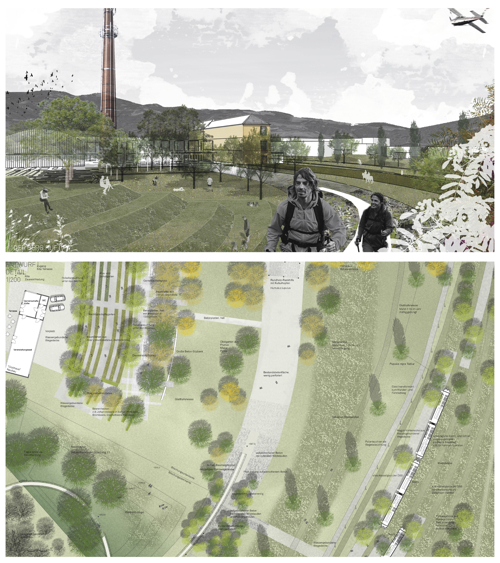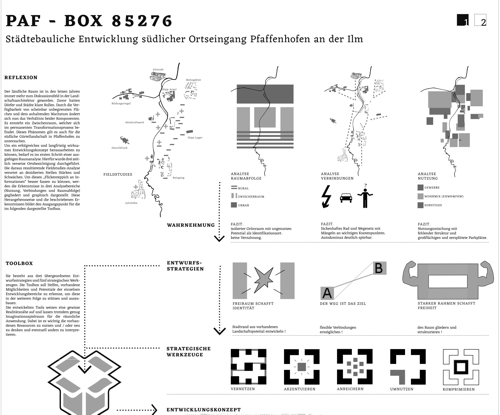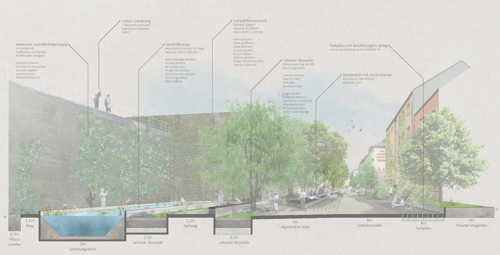Awarded Bachelor and Master Theses 2019
Blue-green infrastructures: Transformation studies of urban open spaces using the example of Frankfurt
Author: Lotta Steger
Bachelorthesis (Professorship Green Technologies in Landscape Architecture)
Supervisors: Prof. Dr. Ing. Ferdinand Ludwig; M. Sc. Friederike Well
Technical University of Munich
© Lotta Steger
Abstract
In view of the ongoing urbanisation and the climatically unadapted, conventional settlement structures, sustainable transformation strategies for urban infrastructure must be developed. The consequences of climate change, especially for urban spaces, put architects, urban planners and landscape architects under pressure, as an improvement of the situation is not in sight without proactive action.
This bachelor thesis develops integrative concept and action approaches for sustainable urban development based on blue-green infrastructures. Through a holistic way of thinking, water demand and water disposal aspects are linked with climatic and ecological aspects and thus not only contribute to solving the increasing challenges such as fine dust pollution, urban heat islands or flooding, but also improve the quality of life and climate balance of cities. By transferring this to space, planning opportunities and limits are also highlighted.
Using the example of Frankfurt am Main, local climatic core problems are recorded and three objectives are defined: Improvement of the microclimate, flood prevention and drinking water protection. In an analysis of the individual challenges, differences in the specific requirements for urban open spaces and their design consequences are elaborated and compared. By combining the three objectives, positive and negative correlations as well as synergetic potentials that have not yet been exploited are presented. In an integrated design based on two inner-city open spaces, Heidestraße and Merianplatz, the blue-green infrastructures are tested for their adaptability and spatial effectiveness and visions for the local actors are developed.
By linking already existing potentials in terms of urban hydrology and vegetation, blue-green infrastructures are used to achieve synergies for the efficient use of limited natural resources. In combination with existing conventional infrastructure, they can contribute to climate resilience and quality of life in urban areas, and in some cases completely replace them. By looking at the concrete space and presenting alternative options, the aim is to reduce reservations in the planning community that still exist in many parts of Europe despite progressive discourse.
Justification for the award
Lotta Steger has worked extremely independently in her bachelor thesis on the topic of blue-green infrastructures. In the course of preliminary studies with different objectives, she delved deeply into the topic and developed her own understanding of the issue. During a site visit, the student identified the two case studies (Merianplatz and Heidestraße) as suitable examples for applying the integrated strategies. She excellently succeeded in translating the theoretically elaborated and systematised principles into two designs. Ms Steger has thus demonstrated her ability to deal with multi-layered and complex problems in an integrated approach.
The thesis was affiliated with the INTERESS-I research project and overall shows a very high level for a Bachelor's graduate. Ms Steger's ability to base her implementation strategies on data and figures deserves special mention. In addition, she clearly presented all steps in the work and prepared the results in such a way that they can be communicated across disciplines. The appealing visualisations have received very high recognition from all partners in the research project, especially the city of Frankfurt. With her Bachelor's thesis, Lotta Steger has succeeded in creating a forward-looking, innovative example of climate-resilient urban design.
BEYOND ALPINE IMAGE – Landscape-aesthetic conception between image and identity in the post-industrial alpine region using the example of the refractory plant in Leoben, Styria
Author: Bernadette Brandl
Masterthesis (Lehrstuhl Landschaftsarchitektur und industrielle Landschaft)
Supervisor: Prof. Dr. Udo Weilacher, M.A Irina Glander
Technische Universität München
Note: Bernadette Brandl has already been awarded the bdla Young Talent Award 2016 for her Bachelor's thesis!

© Bernadette Brandl
Abstract
The former refractory of the Steirische Magnesit-Industrie AG (MAGINDAG) is located in the Austrian city of Leoben-Leitendorf. The tradition-conscious city with its global players in business and research located there strengthens its position as the second largest city in Styria. The 4.2 ha industrial wasteland of MAGINDAG is an example of industrial change in the greater Alpine region since the 1980s. It is precisely these landscape gaps that need to be examined more closely, where the landscape, its socio-cultural, economic and ecological demands, as well as its image and identity are put to the test. "Beyond Alpine Image" gets to grips with how to deal with a new landscape aesthetic in a changing metropolitan area.
The design proposed here is intended to show how Alpine communities like Leoben can view their brownfield sites as an opportunity for a new, sustainable cultural landscape. On the one hand, the local character qualities of the conversion area are elaborated by striving for a careful linkage of open spaces between the urban part of Leitendorf and the Häuselberg and the Mur, which are strongly influenced by the natural environment. On the other hand, the levels of consideration at district and city level are also included, so that local as well as regional offers can contribute to landscape change. Following the model of the spatial image theory of the sociologist Detlev Ipsen, the place is to be modelled according to the needs of today's social development model. A link between traditional or typical local conditions and the new transformation processes is to be established so that the special features of the Alpine location are emphasised and the spatial-sociological significance of this place is revalued. A field of tension between intensive and extensive spaces is created through neighbourly and regional offers. Between image and identity, it is about relating local and regional scale levels to serve as a catalyst for further development in the 21st century.
Rationale for the award
With her work, Bernadette Brandl makes an outstanding contribution to the currently relevant question of how the numerous brownfield sites in the Alpine region can be successfully converted under the special sociological, economic and ecological conditions of a high mountain region. Her work is closely linked to the current EU research project "Transformation of Alpine Industrial Landscapes (trAILs)" under the direction of the Technical University of Munich and not only provides excellent design approaches to solving the problem but also valuable information for practice-oriented research in this complex subject area.
With her very good work, consisting of professionally prepared design plans and models as well as an extensive, exemplary project report, the student impressively proves that landscape architecture can make excellent contributions to solving complex spatial development problems in Europe as a "research design discipline" or "design research discipline".
Exhibiting Landscape. On the transfer of landscape into the interior
Author: Fanny Brandauer
Masterthesis (Lehrstuhl für Landschaftsarchitektur und öffentlicher Raum)
Supervisor: Prof. Regine Keller
Technische Universität München
© Fanny Brandauer
Abstract
How can and why should landscape and landscape elements be exhibited? Can landscape be exhibited at all as a complex, context-dependent system? Or can it only be reproduced fragmentarily, aspectually and broken down into its components? Is it then still landscape or only an image of it? And what does the discipline of landscape architecture have to do with it?
"Exhibiting Landscape. On the Transfer of Landscape into the Interior" attempts to find answers to questions about the interior displayability of landscape. From a landscape architectural perspective, the professional relevance of the medium of exhibition is illuminated and the interface between landscape architecture, fine arts and exhibition practice is examined. The work is divided into three parts: The theory booklet represents the main work of the thesis and comprises the theoretical-analytical part, which deals with exhibited landscapes in interior and exterior spaces, landscape installations and the relationship pair of landscape architecture and visual arts. The design booklet contains all the explanations and illustrations relevant to the concept and design for the practical part of the work "Reminiscence of the Alpine Flower". "Reminiscence of the Alpine Flower" is a spatial installation that deals with remembering a specific landscape. In a closed box that blocks external influences and prevents visual reference to the surrounding space, the chosen landscape is reproduced in a highly concentrated manner.
Urban development of the southern entrance to Pfaffenhofen a. d. Ilm
Author: Alexander Fritsch
Bachelorthesis (Studienschwerpunkt Stadtplanung)
Supervisor: Prof. Christoph Jensen, Prof. Susanne Burger
Hochschule Weihenstephan-Triesdorf

© Alexander Fritsch
Abstract
This thesis deals with the edges of towns and villages in rapidly expanding municipalities and examines their urban development and landscape potential. What role does a village edge play in the perception of a place? What structural functions should it fulfil? What does a wise approach to the edge of a village look like in growing communities? Is there a village edge at all? Starting from a superordinate view, the southern edge of Pfaffenhofen is outlined in its long-term development. In his work, Alexander Fritsch perceived the edge of the town as an intermediate space in a permanent process of transformation, as a "patchwork quilt" of uses, connections and spatial sequences. From these three focal points he derives three design strategies, from which finally five strategic tools are extracted, which are brought together in a toolbox. Using existing resources and / or rethinking or reinterpreting them is crucial for choosing the "right" tool. The reference to the place, to what is already there, is the basis for this.
Justification of the award-worthiness
On a conceptual level, Alexander Fritsch's thesis offers suggestions for dealing with the edges of a place, which lead to a well-founded derivation of action from a focussed analytical, systematic consideration of the place and its individual-situational interpretation. In terms of content as well as space, this can lead to unexpected approaches to solutions. With this toolbox, he demonstrates the ability to professionally examine questions for their content substance and to design them creatively and independently. The topic was theoretically outlined and conceptually and strategically translated into a spatial situation. The spatial realities of the southern edge of Pfaffenhofen as well as the possible visions of its development were focused on and effectively elaborated.
The bdla Young Talent Award is endowed with €250 each and a certificate.
This year's awards took place with the kind support of the offices of grabner huber lipp landschaftsarchitekten und stadtplaner and Rockinger Landschaftsarchitektur on 24 January 2020 as part of the 2020 Members' Meeting.
- Latitude: 0
- Longitude: 0






